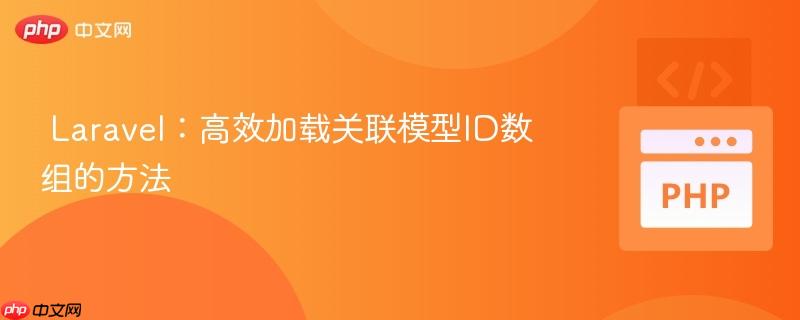
这段代码首先将 $page 模型转换为数组,然后使用 pluck('id') 方法分别从 countries 和 states 关系中提取 id 字段,并将结果赋值给 $result 数组中对应的键。最后,将 $result 作为 json 响应返回。
如果需要加载多个关联关系,可以使用循环来简化代码。
public function view(Page $page)
{
$result = $page->toArray();
$relationships = ['countries', 'states'];
foreach ($relationships as $rel) {
$result[$rel] = $page->{$rel}()->pluck('id')->toArray();
}
//and return as json
return response()->json($result);
}这段代码定义了一个 $relationships 数组,其中包含需要加载的关联关系名称。然后,使用 foreach 循环遍历该数组,并使用 pluck('id') 方法提取每个关联关系的 id 字段,并将结果赋值给 $result 数组中对应的键。
Eloquent Resources 和 Collections 提供了一种转换 Eloquent 模型和集合的优雅方式。你可以创建一个 Resource 类,专门用于格式化 Page 模型及其关联关系。
首先,创建 PageResource 类:
<?php
namespace App\Http\Resources;
use Illuminate\Http\Resources\Json\JsonResource;
class PageResource extends JsonResource
{
/**
* Transform the resource into an array.
*
* @param \Illuminate\Http\Request $request
* @return array
*/
public function toArray($request)
{
return [
'id' => $this->id,
'countries' => $this->countries->pluck('id')->toArray(),
'states' => $this->states->pluck('id')->toArray(),
// 其他属性
];
}
}然后在控制器中使用 PageResource:
use App\Http\Resources\PageResource;
public function view(Page $page)
{
return new PageResource($page);
}虽然 Eloquent 提供了方便的 ORM 功能,但在某些情况下,使用查询构造器可以更高效地获取数据,尤其是在需要复杂的 SQL 查询时。
use Illuminate\Support\Facades\DB;
public function view(int $pageId)
{
$result = DB::table('pages')
->leftJoin('page_country', 'pages.id', '=', 'page_country.page_id')
->leftJoin('countries', 'page_country.country_id', '=', 'countries.id')
->leftJoin('page_state', 'pages.id', '=', 'page_state.page_id')
->leftJoin('states', 'page_state.state_id', '=', 'states.id')
->where('pages.id', $pageId)
->select(
'pages.*',
DB::raw('GROUP_CONCAT(DISTINCT countries.id) as country_ids'),
DB::raw('GROUP_CONCAT(DISTINCT states.id) as state_ids')
)
->groupBy('pages.id')
->first();
if ($result) {
$result->country_ids = $result->country_ids ? explode(',', $result->country_ids) : [];
$result->state_ids = $result->state_ids ? explode(',', $result->state_ids) : [];
}
return response()->json($result);
}这段代码使用 DB::table() 方法创建查询构造器实例,然后使用 leftJoin() 方法连接 pages 表和 countries 表、states 表。使用 DB::raw() 方法执行原生 SQL 函数 GROUP_CONCAT(),将关联的 country_id 和 state_id 聚合为逗号分隔的字符串。最后,使用 explode() 函数将字符串转换为数组。
注意事项:
本文介绍了在 Laravel 中高效加载关联模型 ID 数组的几种方法,包括使用 pluck() 方法、循环处理以及使用查询构造器。选择哪种方法取决于具体的应用场景和性能需求。如果只需要加载少量关联关系,可以使用 pluck() 方法或循环处理。如果需要加载大量关联关系,并且对性能要求较高,可以考虑使用查询构造器。 此外,Eloquent Resources and Collections 也是一种不错的选择,可以提供更清晰的数据转换逻辑。
以上就是Laravel:高效加载关联模型ID数组的方法的详细内容,更多请关注php中文网其它相关文章!

每个人都需要一台速度更快、更稳定的 PC。随着时间的推移,垃圾文件、旧注册表数据和不必要的后台进程会占用资源并降低性能。幸运的是,许多工具可以让 Windows 保持平稳运行。

Copyright 2014-2025 https://www.php.cn/ All Rights Reserved | php.cn | 湘ICP备2023035733号